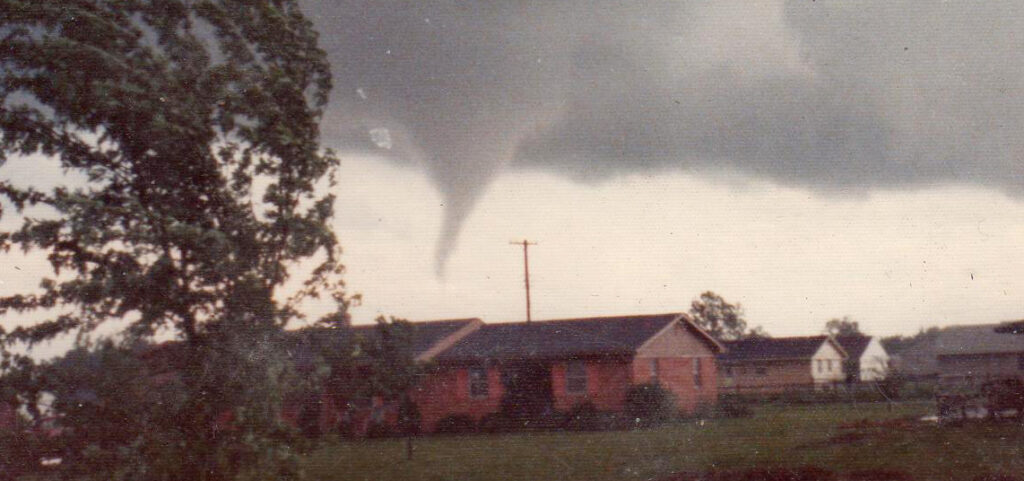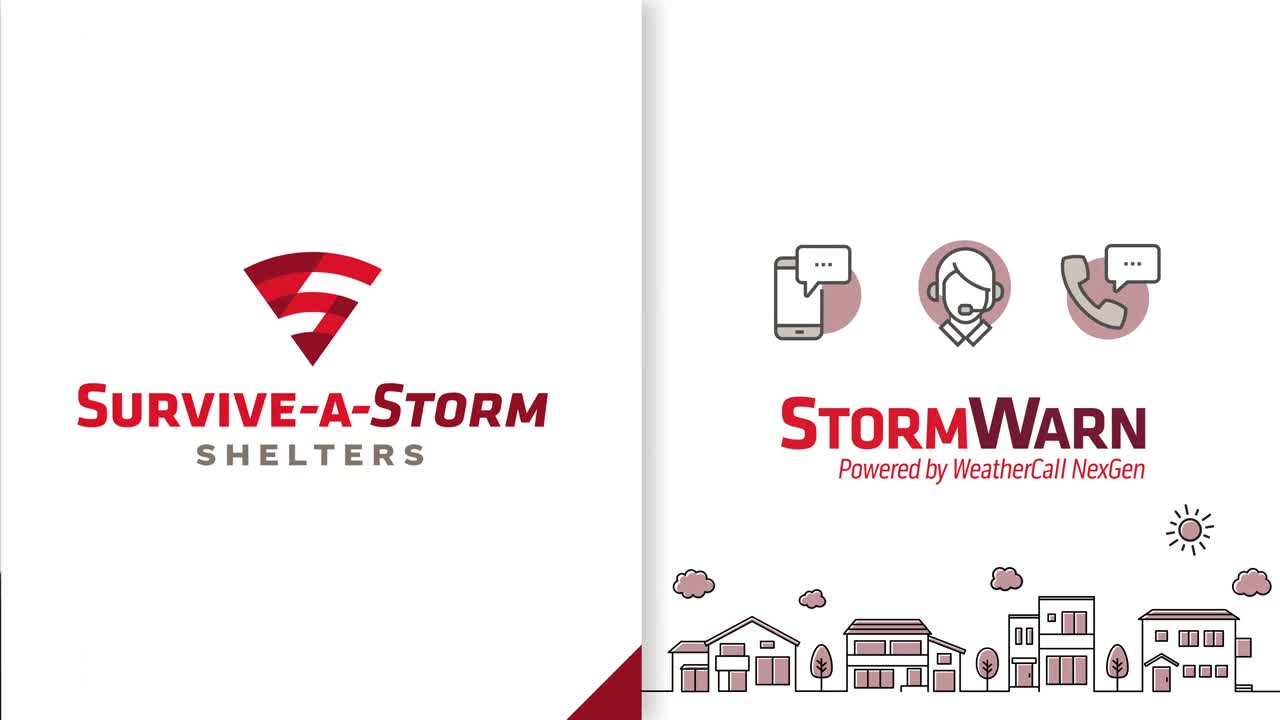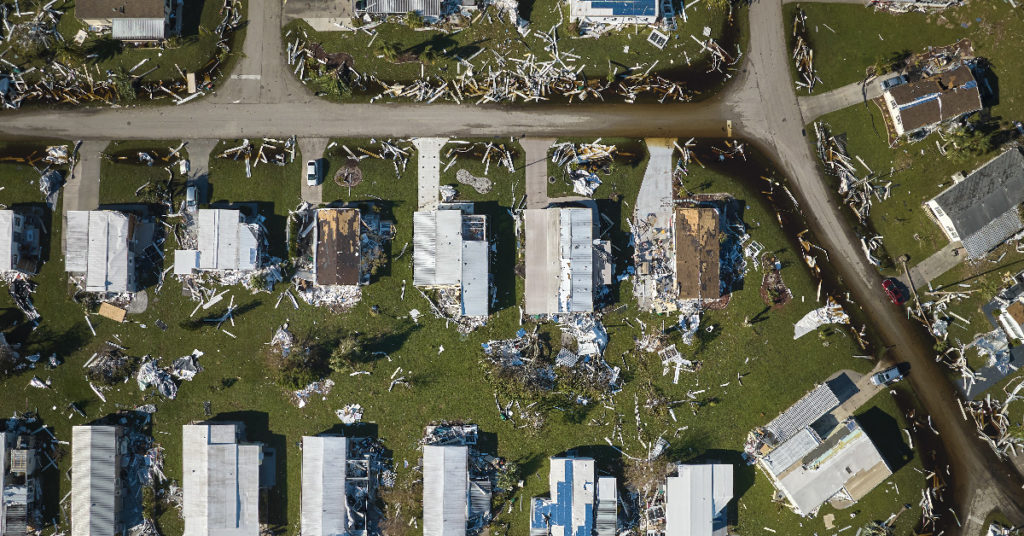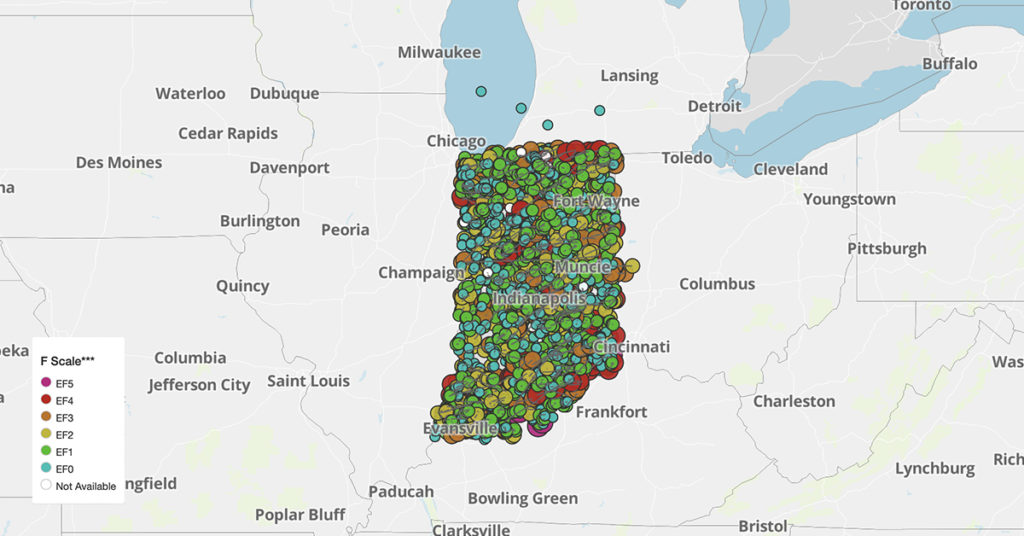Welcome to this comprehensive guide to tornadoes and storm shelters in Indiana. Steeped in rich history, Indiana is renowned for its automotive innovations and thrilling sporting events, but it also has a long-standing relationship with a force of nature that is as powerful as it is devastating–tornadoes. Over the years, the Hoosier State has witnessed numerous tornadoes–with an average of 20 per year–each etching its unique mark in the annals of Indiana history.
These events, while destructive, have underscored the importance of being prepared and having reliable tornado shelters in place. This page serves as a valuable resource on how to effectively prepare for them, locate nearby shelters, ensure your safety during a tornado, and answer common questions you may have about tornado shelters in Indiana.
Here’s some historical data about tornadoes in Indiana history:
- The deadliest tornado in Indiana's history occurred on March 18, 1925, when a tornado hit the town of Tri-State (now known as the Tri-State Tornado). The tornado killed 695 people in Illinois, Missouri, and Indiana, including 71 people in Indiana.
- Indiana has experienced several significant tornado outbreaks, including the Super Outbreak of April 3-4, 1974, which produced 21 tornadoes in Indiana, and the outbreak of June 2, 1990, which produced 37 tornadoes in Indiana.
- The largest tornado outbreak in Indiana's history occurred on April 19-20, 2011, when 38 tornadoes hit the state, causing widespread damage and killing 14 people.
- The most active month for tornadoes in Indiana is May, followed by June and July.
- The EF5 tornado that struck Henryville, Indiana on March 2, 2012, was the first EF5 tornado to hit Indiana since 1974.
- In 2018, Indiana had a relatively quiet tornado season, with only 17 confirmed tornadoes in the state.
- While there are no clear boundaries for Tornado Alley, or the related Dixie Alley, Indiana is located close to both tornado regions, making it an area of high probability for tornadoes.
- Despite the danger posed by tornadoes in Indiana, the state has a relatively low rate of tornado-related fatalities compared to other states in the region, thanks in part to effective warning systems and a high level of public awareness.
Documented Indiana tornadoes since 1950
Preparing for Tornadoes in Indiana
Tornadoes are a significant weather threat to Indiana, and they can strike at any time of the year, though they are most common from late spring through early summer. It is crucial for individuals, families, and the community at large to be prepared for these potentially deadly storms. While most tornadoes are on the weakar end of the Enhance Fujita Scale, they can still cause damage and result in loss of life. Being prepared reduces the impact of a tornado and save lives.
One of the most important aspects of tornado preparation is having a plan. Individuals and families should have a tornado plan in place. This plan should include identifying where they will go. The best place to go is a designated tornado shelter that provides protection from up to an EF5 level tornado. These can be installed in residences, in businesses and some communities also have designated community tornado shelters. Another option is to seek the safety of a basement or interior room on the lowest floor of a building. It is also important to have an emergency kit with supplies like water, non-perishable food, and a first aid kit. To know without a doubt when it is time to take shelter, some people choose to enroll in location-based tornado alert systems like StormWarn that send out alerts when your home is in the National Weather Service's polygon area that denotes the most dangerous area of an active tornado.
Communities can also take steps to prepare for tornadoes. This includes having warning systems in place, such as sirens or emergency alerts, and providing education and resources to residents on tornado safety. Community leaders should work with emergency management officials to identify and to create tornado shelter locations for those who do not have a safe place to go.
In addition to having a plan, it is important to stay informed about weather conditions. Residents should monitor weather reports and be aware of the signs of an approaching tornado, such as dark skies, large hail, and wall clouds or rotating clouds. When a tornado warning is issued, it is important to be prepared to take shelter.

Tornado Shelters Near Me in Indiana
Public tornado shelters in Indiana are typically managed by local government agencies, such as county emergency management offices or local fire departments. Here are a few resources that can help you locate public tornado shelters in Indiana:
It is important to note that not all communities have designated public tornado shelters. In some cases, residents may be advised to seek shelter in their own homes or in the nearest available building. It is important to have a plan in place and stay informed about tornado safety in your area.

Know when severe weather is about to strike and when it's time for you to take shelter with our StormWarn texting program.


Indiana Tornado Safety Tips
Follow these tips to keep you and your family safe if a tornado is approaching your home.
- Plan what your family will do when a tornado threatens your home. Do you have a tornado shelter in your home? If not, you will need to go to the safest place in your home, such as a basement or interior room on the lowest floor. Remember that while determining the safest room is a smart idea, a smarter idea is to install a residential tornado shelter if you don’t have one already.
- If you are in a mobile home, it is important to seek shelter elsewhere. Mobile homes are not safe in the event of a tornado. Make sure everyone knows where to go.
- Have an emergency kit with supplies like water, non-perishable food, and a first aid kit on hand. If you have a tornado shelter, you can keep these items in the shelter.
- Monitor weather reports and be aware of the signs of an approaching tornado, such as dark skies, large hail, and a loud roar like a freight train. When a tornado warning is issued, be prepared to go to your tornado shelter.
- When the time comes, if you are at home, go to your tornado shelter and wait it out, or go to your designated safe place. If you are in a mobile home, leave and seek shelter in a sturdy building or designated tornado shelter.
- If you are in a car, do not try to outrun a tornado. Instead, exit the car and seek shelter in a nearby building or ditch.
- If you cannot find shelter, protect yourself by lying flat in a ditch or low-lying area and covering your head with your hands. Do not seek shelter under a highway overpass, as this can be dangerous and expose you to flying debris.
- After a tornado, be prepared for power outages, gas leaks, and other hazards. Stay away from downed power lines and report any gas leaks to the authorities.
Indiana Tornado Shelter FAQs
Q. How can I locate the nearest public tornado shelter in Indiana?
A. Check with your local county or city emergency management office for information on public tornado shelters near you. You can also look for online resources that list shelter locations in Indiana, such as the Red Cross shelter map.
Q. What are the different types of tornado shelters available in Indiana?
A. Tornado shelters in Indiana can include basement shelters, underground shelters, and above-ground tornado shelters. Each type has its own advantages and specific construction requirements for maximum safety.
It's important to remember that a basement is not automatically tornado-proof. Walk-out basements, for example, or basement areas with large windows are not safe. A basement shelter should still be reinforced to protect occupants from what is happening above them.
And, of course, public or community shelters might be above-ground, or underground, depending on the location. If you plan to shelter in a community shelter, it's very important to plan ahead and to monitor the weather to make sure you are able to reach the shelter in time.
Q. What are the requirements for building a tornado shelter in Indiana?
A. Public tornado shelters in Indiana should adhere to FEMA guidelines (FEMA P-320 and FEMA P-361) and ICC-500 standards, which cover factors such as the shelter location, design, construction materials, and ventilation. They will also take ADA requirements into consideration to accommodate the disabled.
If you're installing a tornado shelter in your home, you may not be required to adhere to those standards, but it is an excellent idea to buy your shelter from a vendor who is a member of the National Storm Shelter Association.
Q. Are there any community or government-funded tornado shelters available in Indiana?
A. Yes, some communities in Indiana offer public tornado shelters, often in places like schools or community centers. Check with your local emergency management office for specific information.
Q. How can I prepare my home for a tornado if I don't have access to a public shelter?
A. If you don't have access to a public shelter, you have a few options. First, you could purchase a residential tornado shelter for use on your property. This could be a permanent above-ground of underground shelter, either installed in your home or outside the home. Or, you can install an above-ground tornado shelter that is anchored onto a slab of thick concrete. For those who rent, some shelters can be moved in the event of a relocation. Many companies have financing options to make keeping your family safe and affordable possibility.
If purchasing a shelter is not within your reach at the moment, you should identify a small, windowless interior room on the lowest level of your home where your family can gather during a tornado. Some experts recommend an interior bathroom because the internal plumbing in the walls is thought to provide additional reinforcement. It's also a good idea to have sports or bike helmets to protect your head and neck.
If you live in a mobile home, it is imperative that you find another place to take shelter. Mobile homes are not safe in a tornado. An above-ground shelter placed nearby, or a community shelter are viable options for a mobile home during a tornado.
Once you've determined where you will shelter, prepare an emergency kit and develop a family communication plan.
Q. Can I bring my pets to a public tornado shelter in Indiana?
A. Policies on pets vary by shelter in Indiana. Some shelters allow pets, while others do not due to health and safety regulations. Always verify the pet policy in advance with the specific shelter.
Q. What should I pack in my emergency kit if I plan to seek shelter in a tornado shelter in Indiana?
A. Include a small amount of nonperishable food and water for each person, medications, important documents, a battery-powered or hand-crank radio, flashlights, extra batteries, a first-aid kit, sanitation and personal hygiene items, cell phone with chargers, and items to comfort you such as blankets or small personal items.
Q. How often are public tornado shelters inspected in Indiana?
A. Inspection frequency can vary by jurisdiction, but generally, public shelters should be inspected at least annually to ensure they remain structurally sound and ready for use.
Q. What is the capacity of the average public tornado shelter in Indiana?
A. The capacity varies widely depending on the size and type of the shelter. Always check with your local shelter for capacity information.



